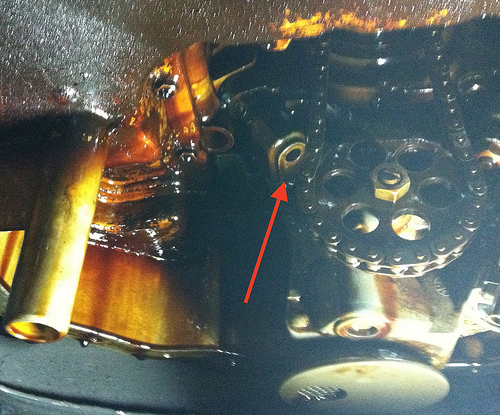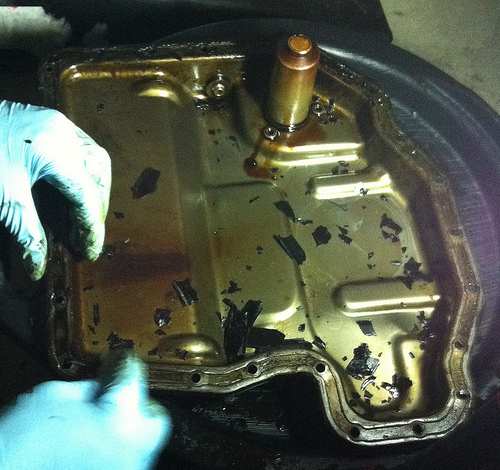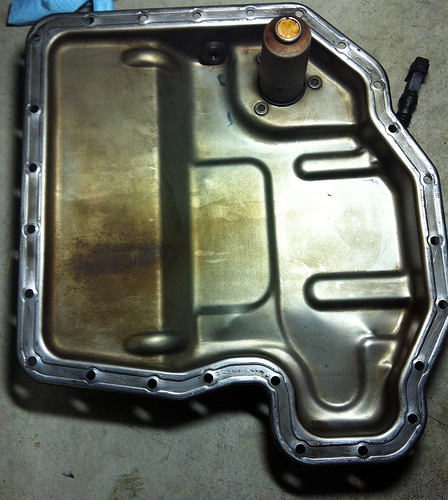Article by: Olin Johnston
Article applies to: all e31, e32, e34, e38, and e39 models with the M60 and M62 V8 engines.
I know this has been brought up numerous times before, but if you own an M60 or M62 engine, DO NOT delay checking your oil pump bolts.
Yesterday, I decided to replace the oil pan gasket during the course of a regular oil change. I planned to take a look at the oil pump bolts in the process since I had heard that they can become loose over time. Let me just say, I’m glad I did!
For starters, the bolts on the oil pan itself were pretty loose. When the pan came down, I was shocked to find that one of the oil pump bolts was entirely off and sitting in the bottom of the oil pan! The others were barely finger-tight, making the whole assembly somewhat movable.
My car has 135,000 miles, and has had a VERY easy life with a full service history. It just goes to show that you can never assume that this was taken care of previously, or that anyone is exempt from this potentially catastrophic design flaw.
To help those interested in doing this, (and you should not wait) here is a little DIY on the oil pan gasket procedure. Not many pictures, sorry. Once you’re in there, it’s pretty easy to know what’s what.
Tools/Materials Needed:
- 8 quarts of your favorite oil
- 1 oil filter (BMW P/N 11 42 7 510 717)
- 1 oil pan gasket (BMW P/N 11 13 1 436 324)
- 36mm socket (or strap wrench) for filter housing
- 10mm socket
- 13mm socket
- 16mm socket
- 17mm socket
- various small socket extensions
- flat razor blade
- catch container for oil
- brake parts cleaner
- Loctite
- Ramps or jack stands
1. Loosen the oil filter cover. It’s always smart to undo this before letting out the oil. Try not to break the rubber mounts. They are fragile, but are also quite cheap.
2. Using the 17mm socket, remove the drain plug on the oil pan and let it drain into the pan/container.
3. Once all the oil has drained out, remove the (many) 10mm oil pan bolts. Remember to disconnect the level sensor and remove the small bracket. Be careful when lowering the oil pan, as it will still be holding a surprising amount of oil. Replace the catch container under the car since it will continue to drain out of the pump etc.
Note the missing bolt.
4. With the oil pan out, scrape off all the near-fossilized gasket material with a razor blade, and clean it heavily with degreaser. Be careful not to gouge it, and make sure it is 100% clean to ensure a good seal on the new gasket. The new one I got from BMW was a very different design than the one that came out. The replacement was rigid with only a thin rubber seal that mated with the inner ridge of the pan. Also remember to clean all the oil pan bolts.
A bristle brush can help with the stubborn gasket material too. Be careful not to score the edges at all.
After: much better, but still some staining from a long time on petroleum based oil.
5. Clean off the oil pump assembly as much as possible. Clean and replace the oil pump mounting hardware. Loctite should be applied to the threads for peace of mind.
6. Reinstall the oil pan with the new gasket aligned. Do not use excessive torque on the pan bolts. Remember to reconnect the level sensor and aluminum bracket. Don’t forget to replace the copper washer on the drain plug with the one included with the new oil filter.
7. Remove the old oil filter. Remember to replace the rubber O-ring on the filter housing cover. Install the new oil filter and tighten the cover 25Nm is the max torque. Over-tightening makes the rubber mounts die early.
8. Refill the oil, start the engine, and check for any leaks. Reset the service interval indicator if you wish.
Enjoy a non-seized motor!




